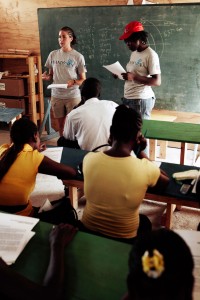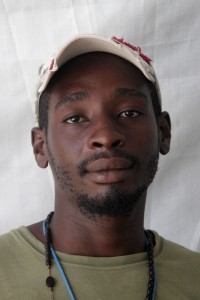
Today marks the 4-month anniversary of the Haiti earthquake that permanently changed the lives of so many on 12 January, 2010. Life quietly, proudly, adamantly goes on. Here at Project Leogane we are surrounded by the pulse of progress amidst the ruins – there is heavy equipment on the roads, construction at schools, and bustle in the markets. There may seem to be rubble mountains beyond rubble mountains, but together the tenacious people of Leogane and our volunteers embody incredible heart, resilience, generosity, and solidarity. For that, may we all be profoundly touched and changed.
Extension!
Project Leogane has achieved remarkable progress in our first 12 weeks of operation. Due to the incredible scale of the needs and what we feel we are still capable to help with, Project Leogane will now run until 15 January 2011! While we expect our programs to gradually transition from early recovery and cleanup to rehabilitation and sustainable development, we will remain committed to our dual goals of benefiting the local community while providing worthwhile, enriching volunteer experiences.
If you’re interested in volunteering , please click over to our Project Leogane Volunteer Information page. The project is full through August but we anticipate some openings in May and June due to rescheduling; we expect to be able to accommodate 60 volunteers at a time on our base through January.
Rubble
Our crews have earned a reputation around town as being an incredibly hard-working, productive force! We’ve cleared 75 homes and 3 schools so far, and have begun doing technical demolition of structures that are dangerously damaged and on the verge of collapse. Often these homes are built in areas too tight for machines to maneuver, so manual work is the only way to get this done. We’ve especially been targeting “vulnerable” families – households with single-parents, female-headed households, expectant mothers, elderly, very young children, etc.
Also, thanks to a very generous donation, we now have 2 Bobcats sitting in our yard! Now we’ll be able to take our demolition and rubble clean-up work to the next level!
 School Build
School Build
Getting children back in school is one of the most effective ways to re-establish routine and normalcy to the lives of youth affected by the earthquake. Two weeks ago, HODR started work on our first transitional school build. The design features a wood frame clad in metal mesh that is plastered to create a finished, masonry look without the collapse risk of block masonry construction. The structures feature earthquake-resistant bracing and hurricane strapping. They’re designed and prefabricated in a way that allows for easy installation, thus ensuring the quality of production and maximizing the opportunity for community participation in the building process. If this all sounds familiar, that’s because this is the same earthquake-resistant design that we used to build homes in West Sumatra, Indonesia earlier this year!
Local Volunteer Program
Our Local Volunteer Program in Leogane has officially launched! Community participation is a hallmark of HODR programs around the world. Initially community members started informally helping on our jobsites, and they’ve naturally transitioned into our more structured program. Three weeks in, an average of about 15 young men and women per day actively participate in the cleanup and rebuilding of their own homes, schools, and community spaces alongside our brigade of volunteers from around the world. This program is a unique opportunity for cultural exchange and professional development on all sides!
ShelterBox
ShelterBox is a Rotary project, providing families with a kit that includes all of the non-food material items that they need to survive the immediate months after a natural disaster. Due to the incredible scale and impact of this event, they’ve returned to Leogane to continue distribution and determine how they can continue to support the community in the months to come. Following a quick training on ShelterBox tent assembly, HODR volunteers registered beneficiary families, ran a tent assembly training, and distributed tents to 190 tents in the rural community of Merger.
Joint Logistics Base
Ground preparation has finally begun on our Joint Logistics Base, the multi-agency warehouse and workshop space hosted in our rear field. Working directly with a number of partner NGOs included CHF International and Canadian Red Cross, we’ll build up the space into a hub of transitional shelter prefabrication and assembly in Leogane.
Plaza Playtime
Dancing, laughing, singing, playing with children – there’s no better way to spend a day! Volunteers continue to run weekly activities for local children, adding Tuesdays and Thursdays at a local orphanage to our Saturday community program. We’ve also expanded our games and activities selected by the children to include art therapy in the program. Whether it’s using crayons, construction paper, markers, leaves, or twigs, the children have demonstrated beautiful creativity, hopes, fears, and dreams through their artwork.
Structural Evaluations
Specialized volunteers play a special role on this project, bringing their structural engineering and architecture expertise to the community through HODR. We continue to complete ATC-20 evaluations for public buildings and private residences (800 in the last week alone!), as well as talk with homeowners about repairs, identifying safe evacuation routes, and how to build back better. These evaluations clarify the true state of damaged structures and offer psychological closure to families grappling with whether to continue living in fear of a home or demolish it. All of our evaluations will be included in the national database of structural evaluations being developed by the United Nations.
ShelterQuest
ShelterQuest! We’ve finally settled on a name for the trio of New York entrepreneurs who brought their simple, cost-effective temporary shelter idea to Leogane and who have now sheltered thousands. Using lightweight PVC piping and heat-shrink boat plastic wrap, ShelterQuest creates family-sized tents for those still living in camps. Every day, volunteers help to unload materials, prefabricate tent parts, and troubleshoot aspects of the design. To date, we’ve prefabricated 1000 tents, installed 200 in camps, and have produced 80 larger units for use as classrooms.
Water System Mapping
Natural disasters often underscore the underdeveloped and poorly maintained infrastructure of vulnerable communities. Leogane is currently receiving potable water from trucks which fill large “bladders” around town – the municipal system has not been operating for years. With the goal of re-establishing long-term, sustainable water service to the town, HODR has partnered with the WASH (Water, Sanitation, and Hygiene) Cluster and the municipal water authority to map the water system. Teams traced the reservoirs, pipes, and valves in the field, marking them with GPS to create a map that will help to plan current repairs and also document the system for posterity.
 Field Hospital
Field Hospital
We continue to supply volunteer “runners” who help with the logistics of day-to-day operations at our local field hospital. From finding supplies, transporting patients, and building shelves to fixing cots, repairing electrical equipment, and inventorying medications, HODR volunteers are filling the gaps and supporting the hospital in providing the highest quality of care to the residents of Leogane.
And the work goes on…
Every day, HODR volunteers find new ways to plug in and support the recovery work in Leogane, as well as to develop our base and volunteer community. Earthquake safety training continues, with over teachers trained to date in how to prepare and respond to earthquakes in the classroom and at home. Following our landlord’s announcement that he was closing the camp in our front yard, we organized and managed a distribution of shelter materials to those 70 families. We’ve prototyped furniture for school classrooms, started a composting system to handle our organic waste, helped UN OCHA to map NGO activities and divide Leogane into zones of activity, and have started working in the mayor’s office to support their operations and information management.
The Volunteers
To date 365 volunteers have joined Project Leogane from 17 different countries. Hundreds more are in the pipeline, and we’re eager to put their skills, talents, creativity, and energy to use here at Project Leogane.
Visitors and Guests
The HODR base is a lively meeting point for the NGO community in Leogane! In addition to Tuesday Night (Salsa Night) at Joe’s Bar, we’ve also hosted NGO staff from ShelterBox, stART International, CHF, and GOAL. HODR board members Pete Kirkwood and Mike McQueeney have volunteered with their families, and we were even joined by the Haiti Lonely Planet author for a week of service. Check out his experience here!
***
HODR is also active around the world, raising awareness and sustaining the relationships from our international programs. Congratulations to all of our volunteers and donors for the successful conclusion of our 6-month earthquake response program in West Sumatra, Indonesia. Thank you to everyone who attended our Haiti awareness event in London in April! We have a number of upcoming events in the US as well:
If you have other events planned, please let us know so we can spread the word!
We’re three months in to our work, but it feels like we’ve just scratched the surface of what we can achieve with the community of Leogane. Thank you to all of our volunteers, donors, and followers for your hard work, love, and support.
Stefanie Chang
Project Director
Project Leogane
Hands On Disaster Response











 After 1,261 schools were destroyed and 2,530 were badly damaged in the 12 January 2010 earthquake, schools in Leogane were unable to operate for three months, depriving children not only of the opportunity for education but also of a sense of normalcy and structured routine. Over the past few months NGOs have worked together to supply tents and tarps for emergency classrooms, but the need still far exceeds current materials and plans.
After 1,261 schools were destroyed and 2,530 were badly damaged in the 12 January 2010 earthquake, schools in Leogane were unable to operate for three months, depriving children not only of the opportunity for education but also of a sense of normalcy and structured routine. Over the past few months NGOs have worked together to supply tents and tarps for emergency classrooms, but the need still far exceeds current materials and plans.






 Friends,
Friends,